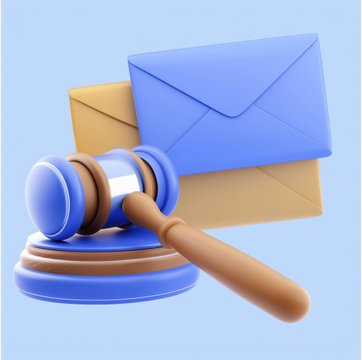How to Improve Email Management for Lawyers: 6 Best Practices

Table of contents
For lawyers and their teams, the sheer volume of incoming emails can be overwhelming. Client communications, court notices, internal memos, you name it.
And that’s not the only issue. A cluttered inbox also makes it difficult to prioritize tasks, and there’s a good chance that some information might slip through the cracks.
But what if I told you there’s a way to keep your inbox clean and improve internal collaboration?
That’s where following certain best practices in email management can help.
But before we get to that, let’s try to understand the challenges with email management in the legal sector.
Common challenges with legal email management
Most lawyers don’t have time to manage their inboxes. In fact, here are some common challenges they face:
- Information overload: Lawyers get a lot of emails from clients, colleagues, courts, and other parties. This can be overwhelming, making prioritizing and keeping track of important messages hard.
- Disorganization: Properly organizing and sorting emails is important. Without a system that helps you do this, inboxes can get cluttered with old threads and irrelevant messages. This can make it hard to find specific information related to a case when needed.
- Confidentiality concerns: Lawyers need access to sensitive and confidential client information. However, many email systems lack strong security features, making protecting data from breaches or leaks difficult.
- Collaboration chaos: Many law firms use email to communicate and collaborate on cases. However, this can confuse, as important updates and documents can get lost in long email threads.
- Time management struggles: A cluttered inbox can distract lawyers from focusing on more strategic legal work, such as research or client meetings.
6 ways to effectively manage legal emails
Below are some actionable strategies to manage shared inboxes in law firms:
1. Prioritize emails based on urgency
Develop a system to prioritize and sort incoming emails. Use filters and shared labels to automatically categorize messages by client, matter, or urgency.
For instance, all emails with the keyword ‘payment’ in the subject line can be labeled ‘Confidential’. This will help separate the urgent from the unimportant and keep your inbox focused on what needs your immediate attention.
2. Utilize folders
Create folders and subfolders within your inbox – to categorize emails in your inbox.
A well-organized filing system makes it much easier to find past information and keeps your inbox clutter-free.
For instance, create folders for compliance-related emails, such as “Legal Notices,” “Regulatory Updates,” and “Compliance Reports.”
This will ensure all necessary documents are readily available for audits or legal reviews, maintaining compliance with regulations.
Pro Tip: Consider using a consistent naming scheme for folders to find important emails easily.
3. Use templates and canned responses
To respond to commonly asked questions and queries, create templates and canned responses.
These help you save time—by not having to write emails from scratch every time—and ensure consistency in communication. Implementing a robust email management software can further streamline this process, enhancing your team’s efficiency and ensuring consistent communication.
Here are some scenarios where using email templates would be helpful:
- Onboarding new clients with a warm welcome, introducing the firm and the team, and outlining the next steps.
- Providing clients with regular updates on the progress of their cases.
- Reminding clients about upcoming appointments or needed documents.
- Informing relevant parties about court filings with attachments and brief summaries.
- Providing clients with a breakdown of fees associated with their cases.
| Here’s a template to respond to a client inquiry Subject: Re: Inquiry – [Brief Description of Issue] Body: Dear [Client Name], Thank you for inquiring about your [Area of Law] matter. I have reviewed your message and would be happy to discuss this further. To schedule a consultation, please call our office at [Phone Number] or reply to this email with your availability. We can discuss your situation in more detail during the consultation and determine how I can best assist you. In the meantime, you may find the following resources helpful: [Link to relevant legal information (optional)] Sincerely, [Your Name] |
4. Use automations to route and tag emails
Many email clients offer features like rule-based automations. These rules automatically sort, label, or forward emails based on specific criteria, such as sender, subject, or content.
Set up rules to automatically route emails to specific folders or flag high-priority messages.
For example, If an email contains keywords like “new client,” “consultation request,” or “legal help,” categorize it under the “Client Intake” label. This ensures that all new client inquiries are instantly categorized and easily identifiable.
If an email contains urgent keywords like “ASAP,” “immediate,” or “urgent,” apply a “High Priority” tag. High-priority emails are flagged immediately, allowing the team to address critical matters promptly.
Note: Want to see this in action? Take an interactive tour.
5. Use a shared inbox for collaboration
What is a shared inbox? A shared inbox is a central hub for all legal emails. Your team can access and get visibility into all incoming requests, track progress on matters, and collaborate seamlessly.
Using a shared inbox eliminates the need to forward emails or rely on one person to respond.
Picture this: A mid-sized law firm specializes in personal injury cases. Its team comprises 5 lawyers (2 senior and 3 junior) and 2 paralegals who handle client intake and initial case assessments.
Challenges without a shared inbox:
- Missed inquiries: When using individual inboxes, there is a risk that new client inquiries may be buried or overlooked, especially during busy periods.
- Inefficient client intake: Paralegals may need to invest additional time in determining which lawyer is best suited for a case based on expertise or current workload.
- Delayed responses: Clients might have to wait longer for a response as their email needs to be forwarded to the appropriate lawyer.
But with a shared inbox…
- All new inquiries from potential clients would be directed to a single “intake” email address.
- Paralegals can quickly review inquiries and assign them to the most suitable lawyer based on specific criteria such as practice area and workload.
- Lawyers can work together and reply to questions faster so that clients get a quick first answer.
Note: See how a shared inbox can help you manage legal inquiries better
6. Use email notes to make internal communication easy
Instead of directly emailing minor updates or questions, team members can use email notes to have internal discussions and set context – right next to the main email thread. This ensures internal and external conversations are neatly separated and avoids unnecessary back-and-forth exchanges.
All team members can access these notes and stay up-to-date on the case’s progress without needing separate internal communication channels.
Using notes improves the overall readability of the conversation and reduces confusion.
Read More:23 Email Management Best Practices and Tips
Wrapping Up…
Managing a legal inbox can be tough. However, the above-mentioned strategies can help you navigate most of these challenges.
While native filters and labels can help you bucket emails, investing in the right tools is also important. They help you automate many tasks and focus on more important tasks.
Take Hiver, for instance. It’s a shared inbox system that can help you automate email assignments, tagging, and more. It can also help your team members collaborate on legal queries – without sending more internal emails – using notes.

































